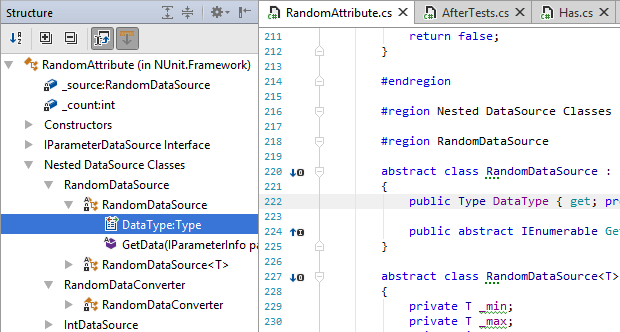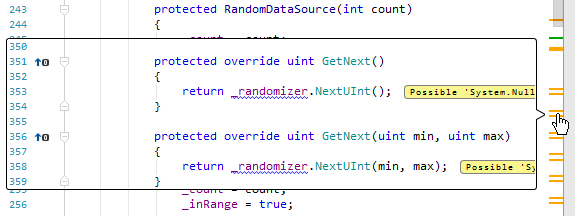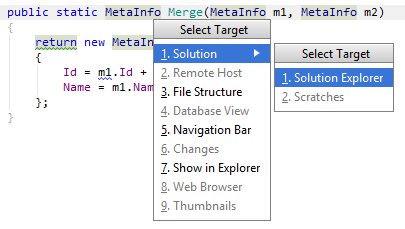Navigate Current Context
JetBrains Rider provides a number of features that help you navigate your code based on the current context, that is according to the opened document and your caret position inside it.
Navigate file by its structure
With JetBrains Rider, you can navigate the structure of the current document using the Structure window, which greatly simplifies navigation in large files. The window is synchronized with the editor: as you switch to another editor tab, the window displays the structure of the corresponding file.
Press N/A or choose .
Contents of the current document appear in a tree structure, that you can explore and navigate through the document. You can double-click any symbol to make the caret in the editor switch to the corresponding position.
-
If some parts of the code are surrounded by
#regionblocks, the regions appear in the file structure too. To synchronize the way you change caret position in the editor with the symbol highlighted in the File Structure window, click Always Select Opened Element
 on the toolbar.
on the toolbar. To synchronize symbols that you select in the File Structure window with the caret position in the editor, click Navigate with Single Click
 on the toolbar.
on the toolbar.
Right from the Structure window, you can access even more actions. To check the available commands, you can right-click any symbol.
- Find usages of symbols Shift+F12
Perform refactorings ( Ctrl+Shift+R)
If the opened file contains unit tests, these are marked with corresponding icons displaying the status of their last execution. You can also run and debug unit tests right from inside the Structure window.

Use editor breadcrumbs
Editor breadcrumbs help you quickly understand where your caret is with regard to the structure of the current document as well as navigate that structure. With editor breadcrumbs enabled, you will always see the path from the root code element to the current caret position right in the editor.

To jump to a parent element in the source code, click the breadcrumb with its name. If you click the namespace element in a C#/VB.NET file, you will be able to navigate to all the files where this namespace is used.
By default breadcrumbs are shown at the bottom of the editor. To display them at the top or hide them altogether, right-click the breadcrumb bar and choose or .
You can also do that as well as configure in which languages and with which colors editor breadcrumbs should be displayed on the page of JetBrains Rider settings Ctrl+Alt+S.
View code outside of the editor frame
You can hover the mouse over the scrollbar to view source code above or below the currently visible area:

You can disable this behavior by clearing the Show code lens on scrollbar hover checkbox on the page of JetBrains Rider settings Ctrl+Alt+S.
Navigate to containing declaration
With a single shortcut, you can jump in the editor to the declaration of a type or a function from any position within its body.
Set the caret into any position within the body of a type or a function.
Press Ctrl+[.
JetBrains Rider will set the caret to the declaration of the type or function.
If the type or function is declared within another type, you can repeat step two to navigate to the declaration of the containing type.
Navigate between members and tags
With the Next/Previous Member commands, you can quickly navigate between members and nested types in code files or between tags in markup files.
When your focus is in the editor, press Alt+Down/Alt+Up or choose in the main menu.
The caret will move to the declaration of the next/previous member/tag. If there are inner types, the caret will also stop at each inner type's member.
Navigate editor tabs and tool windows
You can switch between files opened in the editor, split editor tabs, and tool windows (docked or floating) similarly to your OS application switcher. The switcher brings up a popup consisting of two columns: the left one displays tool windows, the right one editor tabs. If no files are currently opened, or there is just one tab, the switcher shows recently opened files:

-
Press Ctrl+Tab and then keeping the first key pressed (Ctrl on Windows/Linux or ⌃ on macOS), use the following keys:
Left and Right to switch between the lists of tool windows and files.
Up and Down arrow keys, Tab or Shift+Tab to go up and down the list in both panes.
Delete or Backspace to close the editor tab where the selected file is opened and remove the selected file from the list.
Release the Ctrl/⌃ key. The corresponding file or tool window gets the focus, and the switcher popup disappears.
Locate current item in other views
When you select a file, type, member, or other code item in the editor or one of the tool windows, you can quickly locate it in another IDE component.
Press Alt+F1 or select from the main menu. The Select Target popup shows up.
Use the arrow keys or the mouse pointer to select the desired component. If your target is the Solution window, you can select the desired view:

Locate current document in Solution/Assembly Explorer
This handy navigation feature lets you expand the tree in the Solution Explorer, auto-scroll and highlight the item corresponding to the current document. It is especially useful when you have a massive solution, or a limited screen area that forces you to shrink the Solution Explorer window to the limit.
Press Shift+Alt+L.
JetBrains Rider will bring up the Solution Explorer window to focus and show you the item there.
Navigate code by line numbers
The Go to Line command lets you quickly jump to any line of code in the current document.
To go to a specific line in any other file, use the Go To File command (Ctrl+Shift+T), type : (colon) after the target file name, and specify the line number after that.
Press Ctrl+G or choose from the menu.
Type the target line number and optionally, a column number after a colon
:, and then click OK.